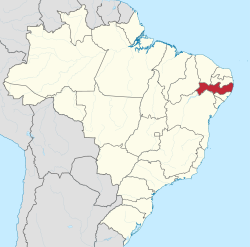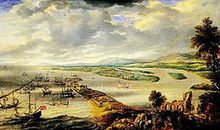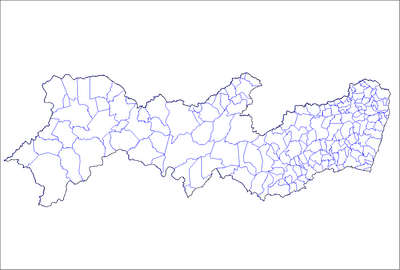Pernambuco
| Pernambuco | |||
|---|---|---|---|
| Symbols | |||
|
|||
| Basic data | |||
| Country | Brazil | ||
| Capital | Recife | ||
| surface | 98,311.6 km² | ||
| Residents | 8,796,032 (2010) | ||
| density | 89 inhabitants per km² | ||
| ISO 3166-2 | BR-PE | ||
| economy | |||
| GDP | R $ 95,187 million (BRL) R $ 10,822 (BRL) per capita (2010) |
||
Coordinates: 8 ° 20 ′ S , 37 ° 49 ′ W
Pernambuco , officially Portuguese Estado de Pernambuco , is a federal state in northeastern Brazil with the capital Recife .
The territory of Pernambucos has an extension of around 98,000 km² and is therefore roughly comparable to the size of Portugal. The population was estimated on July 1, 2019 at 9,557,071 people who call themselves pernambucanos .
geography
Pernambuco in north-east Brazil has a comparatively narrow coastal zone, a higher transition zone called Agreste , and a third inland zone, the so-called Sertão Pernambucano. Neighboring states to the north are Ceará and Paraíba ; after the coast follow Alagoas , Sergipe and Bahia in the south and Piauí in the west. The Fernando de Noronha archipelago in the north-east of the South Atlantic and the rocks of Saint Peter and Saint Paul, located about 960 km off the coast of the state of Rio Grande do Norte, are also part of the national territory.
history
Pernambuco was founded as the Kapitanat Pernambuco ( Capitania , pre-form of the later provinces in the Brazilian colonial empire of Portugal ). King João III subordinated it to Duarte Coelho , a Portuguese nobleman who had already gained a lot of experience during the colonization of India . He drove the economic development of the country with the cultivation of sugar cane. Pernambuco was also one of the few prosperous captains.
Since 1534 the region was under Portuguese rule with a brief interlude of the Dutch from 1630 to 1654 as the Dutch Brazil . Until the beginning of the 19th century, it was very important as a sugar exporter. In the 19th century, Pernambuco was the scene of several political revolts. Today Pernambuco is one of the fastest growing economies in Brazil.
In 1821 the province of Pernambuco was founded as part of the Brazilian Empire , after 1889 it became a separate federal state.
politics
In the 2018 elections in Brazil , here in the gubernatorial elections for the executive branch , Paulo Câmara of the PSB was re-elected as the 57th governor for the 2019-2023 term. He had held this office since 2015.
The legislature is exercised by 49 elected representatives in the Legislative Assembly of Pernambuco . The state sends 25 federal representatives to the Chamber of Deputies and three federal senators to the federal senate of the national congress .
economy
The service sector has the largest share of GDP with 73.2%, followed by the industrial sector with 21.6%. The agricultural sector represents 5.2% of GDP (2006).
Cities
As of July 1, 2019, Pernambuco has a total of 185 individual cities, the municípios , and the Fernando de Noronha state district .
| city | rank | Residents | |
|---|---|---|---|

|
Recife | 1 | 1,645,727 |

|
Jaboatão dos Guararapes | 2 | 702.298 |

|
Olinda | 3 | 392,482 |

|
Caruaru | 4th | 361.118 |

|
Petrolina | 5 | 349.145 |

|
Paulista | 6th | 331,774 |

|
Cabo de Santo Agostinho | 7th | 207.048 |

|
Camaragibe | 8th | 157,828 |

|
Garanhuns | 9 | 139,788 |

|
Vitória de Santo Antão | 10 | 138,757 |
Web links
- Governo de Pernambuco , website of the government of Pernambuco (Brazilian Portuguese)
- ALEPE , Pernambuco Legislative Assembly website (Brazilian Portuguese)
- Pernambuco - Panorama , updated statistics on Pernambuco by the IBGE (Brazilian Portuguese)
Individual evidence
- ↑ a b c Pernambuco - Panorama. In: cidades.ibge.gov.br. IBGE , accessed April 30, 2020 (Brazilian Portuguese).
- ^ História do Estado de Pernambuco. In: gov.br. Governo de Pernambuco, accessed April 30, 2020 (Brazilian Portuguese, Brief History Recap).






